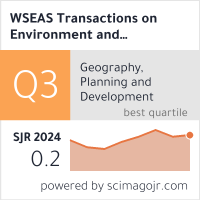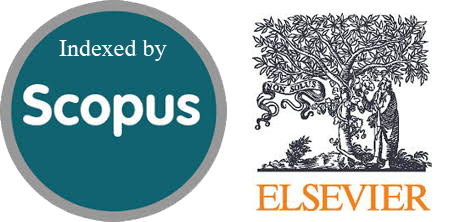Indirect estimation of flow and suspended sediment concentration and load in small mountain streams: An exploratory
Keywords:
Mountain streams, streamflow, dilution gauging, suspended sediments, water turbidity, MadeiraAbstract
The aim of this study was to assess the applicability of indirect techniques for streamflow and suspended
sediment concentration estimation and their use in the calculation of suspended sediment transport rate in the small
mountain watersheds of Madeira Island, Portugal. Emphasis was given to the application of salt dilution gauging
to the indirect determination of the flow rate and the use of water turbidity data to estimate the concentration of
suspended sediments. The field and laboratory work carried out are briefly described, and the main experimental
results and the field data from the short measurement campaign performed in the Ribeira Seca stream in Faial, on
the north side of the island, are presented and discussed. Whilst the measurement campaign carried out was
temporally and spatially limited, it was pioneering for Madeira and allowed to verify the applicability of the
indirect hydrometric and sedimentometric techniques used in this exploratory study.
References
[1] Beniston, M., Environmental Change in Mountains and Uplands, Arnold, London, 2000.
[2] GarcíaRuiz, J. M., MartíBono, C., Lorente,
A., and Beguería, S., Geomorphological consequences of frequent and infrequent rainfall and
hydrological events in Pyrennez mountains of
Spain, Mitigation and Adaptation Strategies for
Global Change, Vol. 7, No. 3, 2002, pp. 303–320.
doi:10.1023/A:1024479630433
[3] Bacchi, B. and Villi, V., Runoff and floods in the
Alps: an overview, in De Jong, C., Collins, D.
and Ranzi, R. (eds.), Climate and Hydrology in
Mountain Areas, Wiley, Chichester, UK, 2005,
pp. 217–220.
[4] Lenzi, M. A., Variation in suspended sediment
concentration during floods in the instrumented
catchment of the Rio Cordon, in Lenzi, M. A.
(ed.), Dynamics of Water and Sediments in Mountain Basins, Bios, Cosenza, 2000, pp. 53–67
[5] Yanto, Livneh, B., Rajagopalan, B., Kasprzyk,
J., Hydrological model application under
data scarcity for multiple watersheds, Java
Island, Indonesia, Journal of Hydrology: Regional Studies, Vol. 9, 2017, pp. 127–139.
doi:10.1016/j.ejrh.2016.09.007
[6] Alipour, M., Streamflow Prediction in Ungauged
Basins Located Within DataScarce Regions,
PhD Thesis, University of Central Florida, Orlando, FL, 2019.
[7] Johansson, B. and Chen, D., Estimation of
areal precipitation for runoff modelling using
wind data: a case study in Sweden, Climate
Research, Vol. 29, No. 1, 2005, pp. 53–61.
doi:10.3354/cr029053
[8] Weingartner, R., Barben, M., and Spreafico, M.,
Floods in mountain areas—an overview based
on examples from Switzerland, Journal of Hydrology, Vol. 282, No. 1–4, 2003, pp. 10–24.
doi:10.1016/S00221694(03)00249X
[9] Canli, E., Loigge, B., and Glade, T., Spatially distributed rainfall information and its potential for
regional landslide early warning systems, Natural
Hazards, Vol. 91, Suppl. 1, 2018, pp. 103–127.
doi:10.1007/s1106901729539
[10] Wohl, E., Mountain Rivers Revisited, American
Geophysical Union, Washington, DC, 2010.
[11] McRoberts, D. B. and NielsenGammon, J. W.,
Detecting beam blockage in radarbased precipitation estimates, Journal of Atmospheric and
Oceanic Technology, Vol. 34, No. 7, 2017, pp.
1407–1422. doi:10.1175/JTECHD160174.1
[12] GouveiaReis, D., Lopes, L. G., Mendonça,
S., A dependence modelling study of extreme
rainfall in Madeira Island, Physics and Chemistry of the Earth, Vol. 94, 2016, pp. 85–93.
doi:10.1016/j.pce.2015.11.006
[13] Gesell, I. W., A Statistical Comparison of
the Accuracy of Precipitation Estimation Using DualPolarization and SinglePolarization
Radar, Senior Thesis, Iowa State University,
Ames, IA, 2017.
[14] Zhang, J., Qi, Y., Kingsmill, D. E., and Howard,
K., Radarbased quantitative precipitation estimation for the cool season in complex terrain:
Case studies from the NOAA Hydrometeorology
Testbed, Journal of Hydrometeorology, Vol. 13,
No. 6, 2012, pp. 1836–1854. doi:10.1175/JHMD110145.1
[15] Shahin, M., Hydrology and water resources of
African islands, in Hydrology and Water Resources of Africa, Kluwer, Dordrecht, 2002,
pp. 565–582.
[16] Leibundgut, C., Maloszewski, P., and Külls, C.,
Artificial tracers, in Tracers in Hydrology, WileyBlackwell, Chichester, UK, 2009, pp. 57–122.
[17] Bolognesi, A., Gottardi, G., and Maglionico,
M., Discharge measurements in a small ungauged
river: comparison between conventional currentmeter and tracer dilution methods, in Ferreira,
R. M. L., Alves, E. C. T. L., Leal, J. G. A. B.
and Cardoso, A. H. (eds.), River Flow 2006: Proceedings of the International Conference on Fluvial Hydraulics, Taylor & Francis, London, 2006,
pp. 1835–1842.
[18] Moore, R. D., Introduction to salt dilution gauging for streamflow measurement: Part 1, Streamline Watershed Management Bulletin, Vol. 7,
No. 4, 2004, pp. 20–23.
[19] Boiten, W., Hydrometry, 3rd ed., CRC Press/
Balkema, Leiden, 2008.
[20] Neupane, S., Vogel, J. R., Storm, D. E., Barfield,
B. J., and Mittelstet, A. R., Development of
a turbidity prediction methodology for runoff–
erosion models, Water, Air, & Soil Pollution,
Vol. 226, 2015, Article 415. doi:10.1007/s11270
01526799
[21] Minella, J. P. G., Merten, G. H., Reichert,
J. M., and Clarke, R. T., Estimating suspended
sediment concentrations from turbidity measurements and the calibration problem, Hydrological
Processes, Vol. 22, No. 12, 2008, pp. 1819–1830.
doi:10.1002/hyp.6763
[22] Sziemer, P., Madeira’s Natural History in a Nutshell, Francisco Ribeiro & Filhos, Funchal, 2000.
[23] Carvalho, A. M. G. and Brandão, J. M., Geologia do Arquipélago da Madeira, Museu Nacional
de História Natural, Lisbon, 1991.
[24] Nguyen, H. T., Wiatr, T., FernándezSteeger,
T. M., Reicherter, K., Rodrigues, D. M. M.,
and Azzam, R., Landslide hazard and cascading effects following the extreme rainfall event
on Madeira Island (February 2010), Natural
Hazards, Vol. 65, No. 1, 2013, pp. 635–652.
doi:10.1007/s110690120387y
[25] Fragoso, M., Trigo, R. M., Pinto, J. G., Lopes,
S., Lopes, A., Ulbrich, S., and Magro, C., The
20 February 2010 Madeira flashfloods: synoptic
analysis and extreme rainfall assessment, Natural Hazards and Earth System Sciences, Vol. 12,
No. 3, 2012, pp. 715–730. doi:10.5194/nhess12
7152012
[26] Baioni, D., Human activity and damaging landslides and floods on Madeira Island, Natural
Hazards and Earth System Sciences, Vol. 11,
No. 11, 2011, pp. 3035–3046. doi:10.5194/nhess1130352011
[27] Hudson, R. and Fraser, J., Introduction to salt
dilution gauging for streamflow measurement,
Part IV: the mass balance (or dry injection)
method, Streamline Watershed Management Bulletin, Vol. 9, No. 1, 2005, pp. 6–12.
[28] Elder, K., Kattelmann, R., and Fergusson, R.,
Refinements in dilution gauging for mountain
streams, in Lang, H. and Musy, A. (eds.), Hydrology in Mountainous Regions, I: Hydrological Measurements; the Water Cycle, IAHS Press,
Wallingford, UK, 1990, pp. 247–254.
[29] Day, T. J., Observed mixing lengths in mountain streams, Journal of Hydrology, Vol. 35,
No. 1–2, 1977, pp. 125–136. doi:10.1016/0022
1694(77)900816
[30] Mao, L. and Carrillo, R., Temporal dynamics of suspended sediment transport
in a glacierized Andean basin, Geomorphology, Vol. 287, 2017, pp. 116–125.
doi:10.1016/j.geomorph.2016.02.003
[31] Tuset, J., Vericat, D., and Batalla, R. J., Water and sediment budgets unveiling contrasting hydrosedimentary patterns in a mountainous Mediterranean catchment, Science of the Total Environment, Vol. 745, 2020, Article 140884.
doi:10.1016/j.scitotenv.2020.140884
[32] Mano, V., Nemery, J., Belleudy, P., and Poirel,
A., Assessment of suspended sediment transport in four alpine watersheds (France): influence of the climatic regime, Hydrological Processes, Vol. 23, No. 5, 2009, pp. 777–792.
doi:10.1002/hyp.7178
[33] Gonçalves, C.C., Gomes, L.A., and Lopes, L.G.,
Lowcost continuous turbidity meter/recorder
for suspended sediment monitoring in mountain
streams, in Andrade, C. (ed.), Book of Abstracts,
International Conference on Ecohydrology and
Climate Change – EcoHCC’09, Polytechnic Institute of Tomar, Tomar, Portugal, 2009, p. 73.
Downloads
Published
Issue
Section
License
Copyright (c) 2020 WSEAS Transactions on Environment and Development

This work is licensed under a Creative Commons Attribution-NonCommercial-ShareAlike 4.0 International License.
Author(s) and co-author(s) jointly and severally represent and warrant that the Article is original with the author(s) and does not infringe any copyright or violate any other right of any third parties and that the Article has not been published elsewhere. Author(s) agree to the terms that the WSEAS Journal will have the full right to remove the published article on any misconduct found in the published article.




